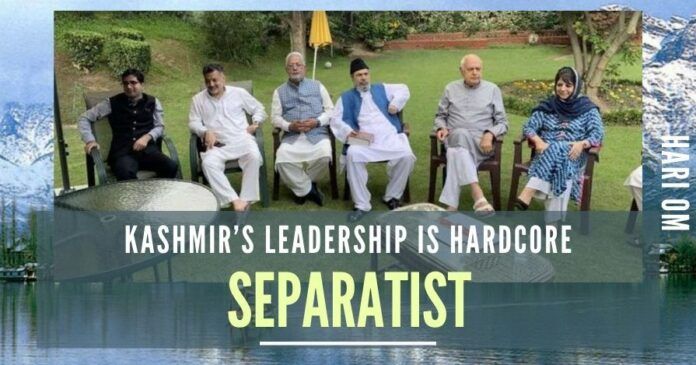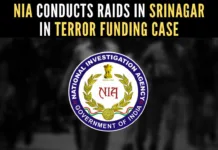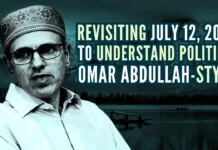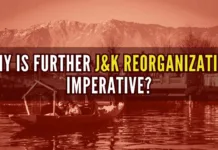
Separatist hate and despise democracy and love and hail theocracy
Political class, think-tanks, trouble-shooters, commentators, reporters, people in general, nay almost all, including enemy nations and international bodies, consistently describe the disturbing happenings in the Valley as the direct fallout of what they call “Kashmir problem”. They are wrong. Theirs is a highly flawed/motivated narrative.
The truth is there is no Kashmir problem. There is a problem in Kashmir. And the causes of the problem are deeper. One of the most notable causes is the urge in Kashmir for separation from India and the desire for Pakistan/Syria/Saudi Arabia-type regime. To be more exact, they hate and despise democracy and love and hail theocracy. They vouch for a system similar to the one prevalent in medieval India. That system was known the world over as an era of bloodshed, murder, conversion, migration, and dethronement of liberal and all-embracing and all-accommodating indigenous regimes. This is a hard reality. India suffered enormous socio-cultural and politico-economic losses during the medieval period.
Kashmir has been one of the most prosperous and highly developed regions in the country.
Kashmir has been witnessing the dance of death and destruction and the process of elimination, conversion, and migration since 1339. The only period that witnessed relative peace in Kashmir was between 1819 and 1947. During this period, the Sikhs of Punjab (1819-1846) and the Dogras (1846-1947) ruled Kashmir. It’s a different story that no “secular” historian, politician, and commentator talk about it. But it’s not altogether unexpected. This is one sad part of the story.
The other is the oft-repeated claims in certain quarters in Kashmir and outside that poverty, unemployment, under-development, and denial of political say to Kashmiri Muslims in the governance of the state are responsible for the rise of a violent secessionist movement in the valley. It’s a distortion of facts. It’s an ugly attempt on the part of vested interests to suppress the truth and mislead the nation and the international community.
Kashmir has been one of the most prosperous and highly developed regions in the country. Not one Kashmiri to date has died of hunger or cold. Per capita meat consumption in Kashmir is the highest in the world. Per capita expenditure on woolen clothing in Kashmir is highest in the country. Not one Kashmiri is without a house. In fact, many Kashmiris have houses in Kashmir and outside. It’s well known that Kashmiris in their thousands go out of Kashmir for months during winter to avoid the cold conditions. Most of them come to Jammu and live either in their own second houses or in official and semi-official buildings. In addition, many have set up colonies in Jammu. These are exclusively for themselves and these colonies are worth living.
As for trade, transport, tourism, hotel industry, and cottage industry, almost 100% of Kashmiris run and control them. As for big and small government contracts in Jammu, Kashmir, and Ladakh, the powers-that-be in the erstwhile J&K State and UT of J&K had been preferring Kashmiris over the interested parties in Jammu and Ladakh. And, it’s not a secret. Even today, they get most of the contracts.
Believe it or not, but it’s a fact that J&K received 10% of all “Central grants given to states over the 2000-2016 period”.
In terms of road connectivity, power generation, educational and healthcare facilities, universities, professional and technical institutions, jobs in government and semi-government establishments, horticulture and sericulture, financial institutions, and seats in medical and engineering colleges and agriculture universities, Kashmir is far superior to Jammu province and many other parts of the country. They are so privileged. That so privileged can also be seen from the fact that while Kashmiri youth hold more than 3.8 lakh jobs out of a total of nearly 4.5 lakh government jobs, youths of Jammu province have to remain content with only 70,000 such jobs. It could happen because the Kashmiri ruling class controlled and guided all the recruitment agencies. It would not be out of place to mention here that the number of government employees in Bihar is just 3.7 lakh – 10,000 less than Kashmir. What’s the population of Bihar? It’s almost 19-time more than Kashmir.
What about the political say of Kashmiri leaders? They led the state between 1948 and 2018. They dominated the state legislature as they in collaboration with New Delhi in 1951 manipulated more than 50% seats in the Assembly, which discussed and decided questions of supreme importance to the happiness and well-being of the people. They dominated, and continue to dominate, Civil Secretariat, the seat of government. Over 80% of employees in the Civil Secretariat were, and are, from Kashmir. And who headed the crucial, sensitive and nation-building Finance, Planning, Home, Revenue, Agriculture, Forest, Law, Education, and General Administration Departments and office of Advocate General? All know that all were from Kashmir. All from one particular community in Kashmir controlled these departments. The fact is that all political, administrative, and financial institutions, technical and professional institutions, and recruitment agencies were the sole preserve of the Kashmiri ruling elite.
A few words on the funds being pumped into Kashmir by the over-generous New Delhi would also be in order. Believe it or not, but it’s a fact that J&K received 10% of all “Central grants given to states over the 2000-2016 period”. It happened despite the fact that J&K constituted a paltry 1% of India’s population. What about UP, which housed the country’s 13% population? It received only “8.2% of the Central grants in 2000-2016”. In other words, J&K, which housed 12.55 million people as per the 2011 census, got “Rs 91,300 per person over the last 16 years while UP only received Rs 4,300 per person over the same period”. Not just this. J&K also received a “disproportionate amount of Central assistance”. According to an analysis by The Hindu of Central and State finances, “J&K received 1.14 lakh crore in grants over the 16 years (2000-2016), which is more than a quarter of the Central funds disbursed to the 11 special category state in that period”[1].
All this should clear all the cobwebs of confusion and establish that the causes responsible for the rise of politics of separatism, based on religious fanaticism, are deeper. Will the people start saying problems in Kashmir? They should. They should do all the more taking into consideration the composition and complexion of the Farooq Abdullah-led 8-party Gupkar Alliance, called “Gupkar Gang” by over 260 retired bureaucrats, Army officials, judges, and educationists.
Note:
1. The views expressed here are those of the author and do not necessarily represent or reflect the views of PGurus.
References:
[1] J&K gets 10% of Central funds with only 1% of population – Jul 24, 2016, The Hindu
- ‘Kashmir My core constituency’: Revisiting July 12, 2003 to understand politics, Omar Abdullah-style - March 15, 2024
- Total deviation from traditional approach: Seven takeaways from PM Modi’s March 7 Srinagar visit - March 9, 2024
- Status of political parties: Why is further J&K reorganization imperative? - March 1, 2024










